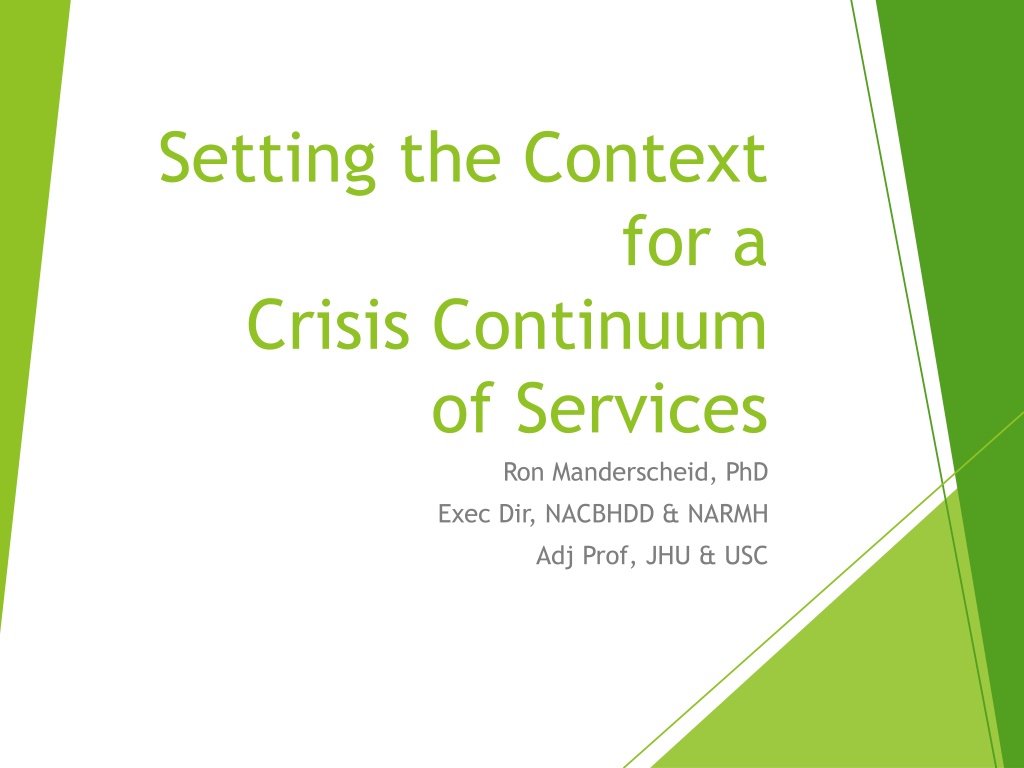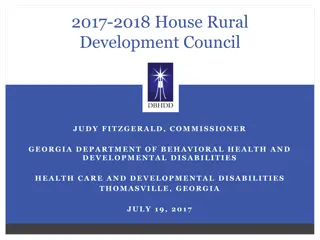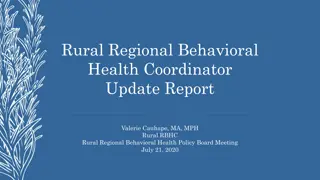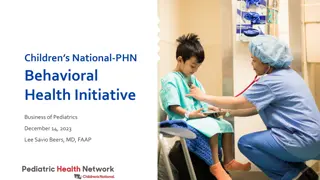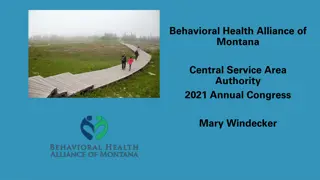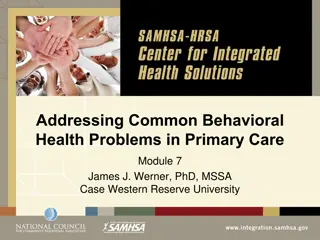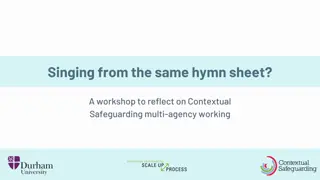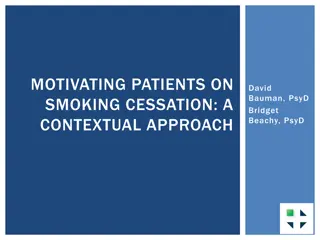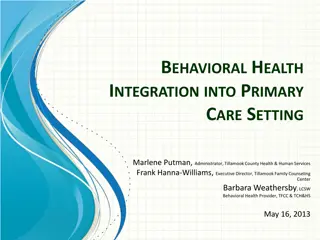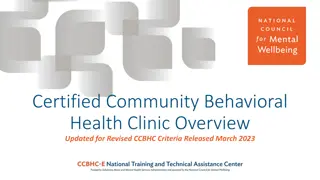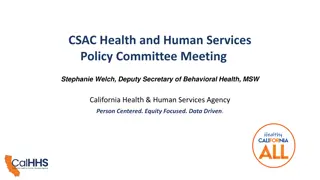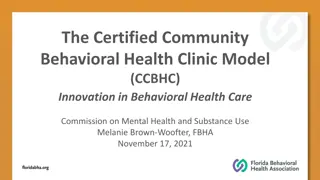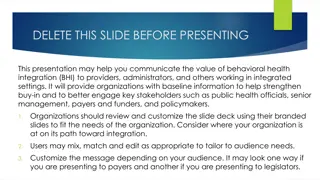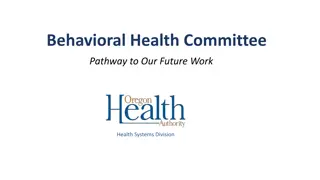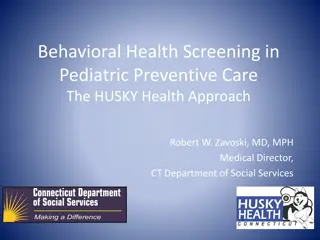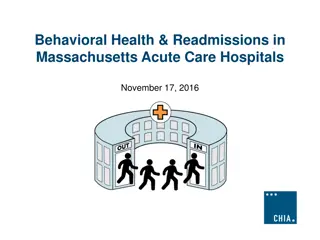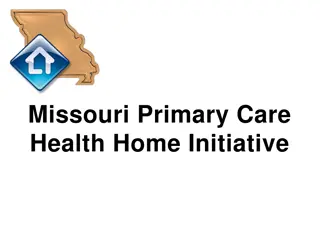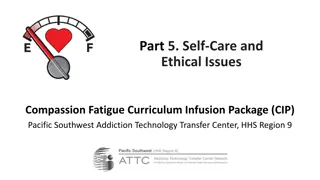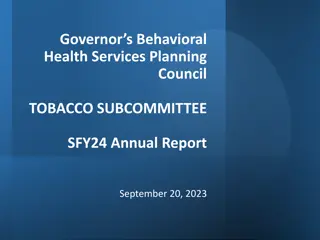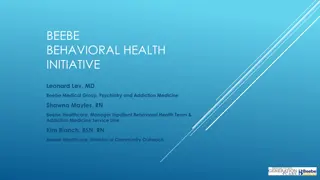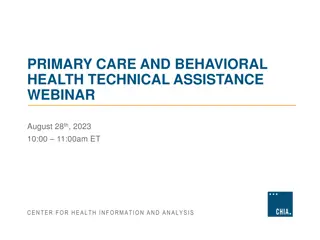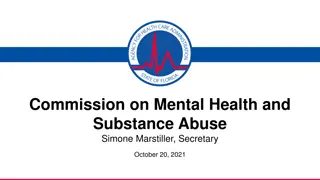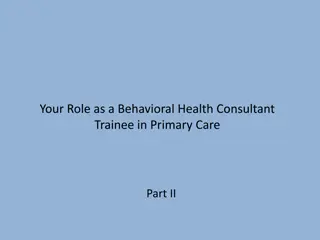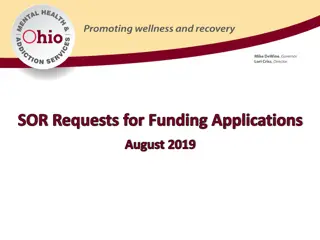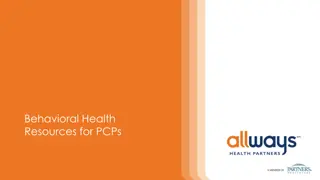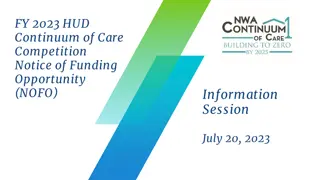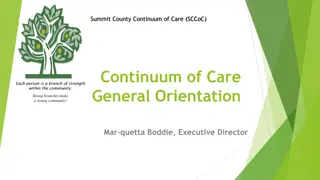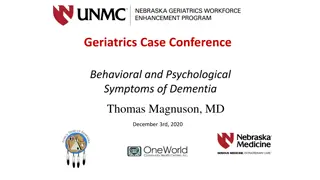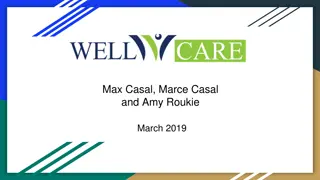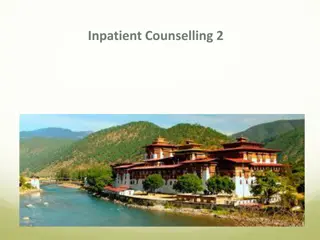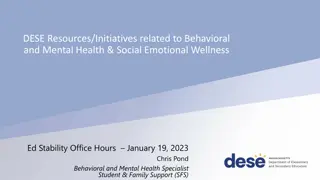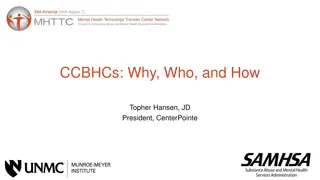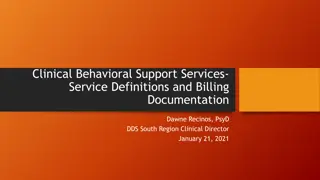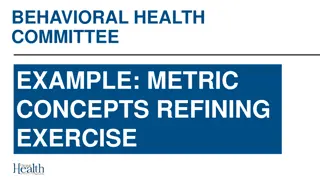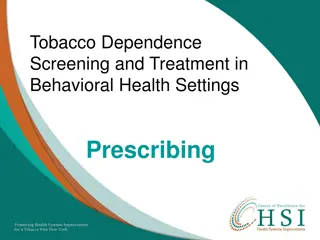Contextual Overview of Behavioral Health Challenges and Care Continuum
This collection of images and snippets provides insights into the current landscape of behavioral health services, highlighting the critical need for enhanced care continuum. It addresses the prevalence of behavioral health conditions, challenges in meeting the demand for care, and the gaps in accessibility to services. The data underscores the importance of a comprehensive approach to address mental health and substance use disorders effectively in our communities.
Download Presentation

Please find below an Image/Link to download the presentation.
The content on the website is provided AS IS for your information and personal use only. It may not be sold, licensed, or shared on other websites without obtaining consent from the author. Download presentation by click this link. If you encounter any issues during the download, it is possible that the publisher has removed the file from their server.
E N D
Presentation Transcript
Setting the Context for a Crisis Continuum of Services Ron Manderscheid, PhD Exec Dir, NACBHDD & NARMH Adj Prof, JHU & USC
Amanda Gorman Challenges Us The new dawn blooms as we free it For there is always light, if only we're brave enough to see it If only we're brave enough to be it
Greetings & Best Wishes I bring greetings and best wishes to each of you from our county behavioral health directors, our rural colleagues, and the members of the national Coalition for Whole Health.
Where We Are Going Today Context of Behavioral Health/Behavioral Care COVID-19 and Behavioral Health/Behavioral Care Context of Population Behavioral Care Implementing Population Behavioral Care Implementing Population Racial Equity Building Our Communities Building a Community Crisis Response System
Context of Behavioral Health and Care -1 25% of adults and 20% of children and adolescents have diagnosable behavioral health conditions (annual prevalence). About 6% of adults and 9-13% of adolescents have serious and persistent mental health conditions.
Context of Behavioral Health and Care -2 More than 11% of those age 12 and older use illicit drugs, and more than 2% use prescription drugs for non- medical purposes. Drug overdose deaths are approaching 80,000 per year. Almost 50,000 persons die by suicide each year. About 8.5 million persons have co-occurring mental health and substance use conditions.
Context of Behavioral Health and Care -3 No more than half of adults and a quarter of children and adolescents with behavioral health conditions receive any care at all. Only about 20% of these adults receive care from a behavioral health provider; 80% receive care from a primary care provider. Many who do not receive care are homeless or incarcerated in city and county jails.
Context of Behavioral Health and Care -4 The behavioral care field suffers from a severe human resource crisis senior providers are leaving and junior providers are not entering in sufficient number. More reliance is being placed on peer supporters, virtual care, and self-care. Behavioral care has been very slow to adopt integrated care approaches.
COVID & Behavioral Health - 1 COVID-19 and its mitigation strategies are generating a behavioral health pandemic. A recent CDC survey conducted in June 2020 shows: 41% of adults had at least one mental or behavioral consequence. 31% - anxiety or depression 26% - trauma or stress
COVID & Behavioral Health - 2 13% - increased substance abuse 11% - contemplated suicide Even more concerning: 33% of unpaid caregivers contemplated suicide 25% of those 18-24 contemplated suicide 22% of essential health workers contemplated suicide All of these rates are expected to grow even further over the next 12 months.
Behavioral Care Also Has Changed
COVID and Behavioral Care -1 In one month (April 2020), behavioral care transitioned from interpersonal to virtual. This has led to important learnings. Behavioral care had great difficulty acquiring PPE. Mental hospitals and local jails deinstitutionalized rapidly, leading to problems in local communities.
COVID and Behavioral Care -2 Revenue of behavioral care organizations fell 40-50%, and has recovered only partially. Important gains made in expanding virtual behavioral care may be limited unless permanent extensions can be achieved through Federal Medicaid and Medicare. The estimated financial shortfall in behavioral care is about $38 billion. Overall: In states, $500 billion; in counties, $150 billion.
What can be done? The current crisis in behavioral care can be partially mitigated through implementing population behavioral care: Prevention always is preferred over treatment. Such changes also will mitigate behavioral health crises in the community.
Context of Pop. Behavioral Care- 1 Although coming only slowly, population behavioral care now is seen as critical to the future of the behavioral care field, including for crisis care. Underlying Model: Negative Social/Physical Determinants of Health Personal and Family Trauma Health and Behavioral Health Consequences Need for Care and Support
Context of Pop. Behavioral Care - 2 Trauma causes about 85% of all behavioral health conditions. Example: Adverse Childhood Experiences (ACEs) Example: Trauma Informed Care & Trauma Informed Recovery Now recognized that persons in the behavioral care field also will need training in public health and community interventions. Joint degrees are becoming more common.
Important Questions We Can Pose: Can we use population behavioral care strategies to prevent and reduce the behavioral health and social effects of COVID-19 and its mitigation efforts? Can we use population behavioral care strategies to prevent and reduce behavioral health crises that occur in the community?
Moving Pop. Behavioral Care-1 In population behavioral care, the essence of disease prevention and health promotion is changing community-level negative social and physical determinants of health and implementing positive ones. To do this, we will need to deconstruct these determinants, identify their origins, and modify these origins. Thus, we can bring change to communities that will result in population-level change for all who are exposed to these determinants.
Moving Pop. Behavioral Care - 2 Negative social and physical determinants range from simple to complex: From rats in a house to poor quality education or poverty. Positive social and physical determinants also range from simple to complex: From good quality housing to a supportive environment that promotes resilience. We will need to develop the capacity to address the full range of these determinants.
Moving Pop. Behavioral Care- 3 To do this, public health strategies directed at changing community social and physical health determinants will need to be linked to population health management strategies directed at subsets of people who have similar exposure to these determinants. A key part of this work will involve extensive collaboration that spans public health, behavioral health, population health management, and health care.
Thus, Population Behavioral Care has a Key Role to Play in Preventing and Reducing Behavioral Health Crises that Occur in the Community.
Illness and Wellbeing --1981 VERY GOOD WELLBEING l I NO DISEASE -----|-----SEVERE DISEASE l l l VERY POOR WELLBEING
Viewed as Population Health VERY GOOD WELLBEING l Pop 2 I NO DISEASE ----- | -----SEVERE DISEASE l Pop 3 l Pop 4 l VERY POOR WELLBEING Pop 1
Adding the Third Dimension W C E O L M L ILLNESS B ILLNESS E U I N N I G T Y
Population Health Management can Partition Populations into Different Levels of Exposure to Specific Social and Physical Determinants of Health and into Different Levels of Propensity to Experience Crises. Thus, Population Behavioral Care can Modify These Determinants, Their Antecedents, and Their Consequences.
Moving Pop. Racial Equity - 1 Systemic racism is baked into our basic community institutions education, economy, religion, family, health care. As a result, minority persons experience trauma through these institutions via negative social and physical determinants of health. Thus, in the extreme, these minority persons will develop adverse health and behavioral conditions as a result of exposure to these determinants, in some cases even death.
Moving Pop. Racial Equity - 2 What are the sources of these systemic racism determinants? Power dynamics in our institutions: Status power; economic power; political power; personal power; knowledge power. All types of power. The solution will involve organizing, engaging, and changing these power dynamics, e.g., in community schools.
Moving Pop. Racial Equity - 3 Key partnerships will need to be built among businesses, not-for-profit entities, and government agencies to change the power dynamics in our institutions that support systemic racism and its effects. Once the power dynamics have been changed, then public health, population behavioral care, population health management, and health care can modify the relevant social and physical determinants of health that result from systemic racism.
Building communities is an important tool to prevent and reduce community behavioral health crises.
Building Communities Rural Behavioral Health Collaborative in the International Initiative on Mental Health Leadership (IIMHL) Understanding How Communities Can be Organized and Self-Organize to Address Community Problems, including Behavioral Health Crises. First Outreach: Five Texas Counties funded by the Hogg Foundation. Planning Additional Outreach in Canada, Netherlands, Australia, and New Zealand. Goal: Learn Best Practices so that They can be Transported.
Some Learnings from Texas Counties Foundational: Always listen to your community Redefine inclusivity Get things done through relationships and interactions Moving from an approach based upon traditional coalitions to one based upon networks. Once networks are developed, shared leadership can begin to emerge. This was described as leaderful groups.
Building Community Crisis Response Systems Three Tiers: Capacity for Virtual In-reach and Out-reach Capacity for Mobile Crisis Response Teams Capacity to Operate a Diversion Center Related Activities: Crisis Intervention Training for Police Mental Health First Aid for Key Groups in the Community
Some Examples Regional Crisis Diversion Centers in Kansas County Crisis Diversion Center Set Up by Washington County, OR LA County Project to Move Crisis Response from the Police Department to EMS Responders Crisis Intervention Training in San Antonio, TX
Putting It All Together Community Level Prevention Through Addressing the Social and Physical Determinants of Health + Community Level Population Behavioral Care to Reduce Behavioral Health Crises + Appropriate Training of Police and Key Community Groups. + Configuring a Three-Tiered Community Crisis Response System
How will we respond to these challenges?
Commentaries My commentaries are available at Behavioral Healthcare Executive (www.behavioral.net)
Contact Information Ron Manderscheid, PhD, President/CEO NACBHDD The National Assn of County Behavioral Health and Developmental Disability Directors NARMH The National Assn for Rural Mental Health (V) 202-942-4296 (M) 202-553-1827 rmanderscheid@nacbhd.org The Only Voice of County and Local Authorities in the Nation s Capital!
